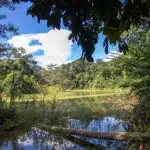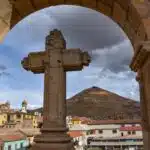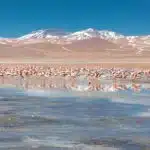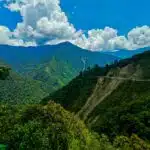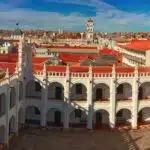Copacabana and Lake Titicaca, located high in the Andes, is one of Bolivia’s most breathtaking and culturally significant destinations. As the world’s highest navigable lake, perched at an altitude of 3,812 meters (12,507 feet), it offers a unique opportunity to explore stunning natural landscapes and rich cultural heritage. Sailing on the Bolivian side of Lake Titicaca provides an unforgettable experience of tranquility, history, and tradition.
Why Sail on Copacabana and Lake Titicaca?
Sailing on Lake Titicaca is like stepping into another world. The deep blue waters, framed by the majestic Andes mountains, create a serene and almost mystical atmosphere. The lake has been revered for centuries by the indigenous Aymara and Quechua people, who believe it to be the birthplace of the Inca civilization. This spiritual significance, combined with the lake’s natural beauty, makes it a must-visit destination in Bolivia.


Highlights of Sailing on the Bolivian Side
- Isla del Sol (Island of the Sun)
- The crown jewel of Lake Titicaca, Isla del Sol, is the largest and most important island on the Bolivian side. According to Inca mythology, the island is the birthplace of the sun god Inti and the first Inca king, Manco Cápac. The island is dotted with ancient ruins, such as the Sacred Rock and the Pilko Kaina temple, offering a fascinating glimpse into the region’s rich history. Sailing to Isla del Sol allows you to explore these archaeological treasures, hike through terraced hills, and enjoy panoramic views of the lake.
- Isla de la Luna (Island of the Moon)
- Just a short sail from Isla del Sol, Isla de la Luna is smaller but equally enchanting. It’s believed to be the home of Mama Quilla, the moon goddess. The island’s main attraction is the Iñak Uyu, or Temple of the Moon, where Inca priestesses are said to have lived. Visiting Isla de la Luna offers a peaceful retreat with less tourist traffic, perfect for those looking to experience the lake’s more serene side.
- Traditional Reed Boats
- While sailing on Lake Titicaca, you might come across the balsas de totora, traditional boats made from the lake’s totora reeds. These boats have been used by the indigenous people for centuries and offer a unique and authentic way to experience the lake. Some tours offer the chance to ride on these reed boats, providing a deeper connection to the cultural heritage of the region.
- Copacabana
- Your journey on Lake Titicaca will likely begin in Copacabana, a charming town on the shores of the lake. Copacabana is famous for its stunning white basilica and as a pilgrimage site for those seeking blessings from the Virgin of Copacabana. Before setting sail, take some time to explore the town’s vibrant markets, sample local cuisine, and perhaps climb the Cerro Calvario for a spectacular view of the lake.
The Sailing Experience
Sailing on Lake Titicaca offers a blend of adventure and relaxation. The lake’s vastness means that each voyage feels like a journey into the unknown, with the distant islands appearing like mirages on the horizon. The calm waters and the gentle breeze make for a peaceful sailing experience, allowing you to fully immerse yourself in the lake’s tranquil beauty.
Private Tours and Group Excursions: Whether you prefer a private sailing experience or a guided group tour, there are options to suit every traveler. Private tours offer more flexibility and the opportunity to explore less-visited areas, while group excursions provide a social atmosphere and often include knowledgeable guides who can share the history and legends of the lake.
Sunsets on the Lake: One of the most magical moments on Lake Titicaca is witnessing the sunset from the water. As the sun dips below the Andes, the sky transforms into a canvas of oranges, pinks, and purples, reflecting on the lake’s surface. It’s a sight that stays with you long after you leave.

Cultural Immersion
Sailing on Lake Titicaca isn’t just about the scenery—it’s also a chance to connect with the local communities. Many of the islands, especially Isla del Sol, are home to Aymara people who maintain a traditional way of life. Staying in local guesthouses, sampling home-cooked meals, and participating in daily activities like farming and weaving are all ways to experience the authentic culture of the lake.
Handicrafts and Souvenirs: The islands are known for their beautiful textiles, handmade by local artisans. These vibrant fabrics, often featuring traditional Andean patterns, make for meaningful souvenirs and support the local economy.
Festivals and Rituals: Depending on the time of your visit, you might have the opportunity to witness or participate in local festivals, which often involve music, dance, and offerings to the lake’s deities. These events offer a unique insight into the spiritual life of the communities.
How to Get to Copacabana
Getting to Lake Titicaca from the Bolivian side is relatively straightforward. The main gateway to the lake is the town of Copacabana, which is well-connected by road from major cities in Bolivia.
- From La Paz: The most common route is from La Paz, Bolivia’s capital. Buses and shared taxis regularly depart from La Paz to Copacabana, a journey of approximately 3.5 to 4 hours. The route includes a short ferry crossing at the Tiquina Strait, where you’ll need to disembark and take a small boat while your vehicle is ferried across separately.
- From Puno (Peru): If you’re coming from the Peruvian side of Lake Titicaca, you can take a bus from Puno to Copacabana. The journey takes about 3 to 4 hours and includes a border crossing at Kasani.
Once in Copacabana, you can arrange boat trips to Isla del Sol, Isla de la Luna, and other points of interest on the lake.
Tips for Visiting Copacabana and Lake Titicaca
- Acclimatize to the Altitude: Lake Titicaca is located at a high altitude, so it’s essential to acclimatize properly before engaging in physical activities. Spend a few days in La Paz or Copacabana to adjust to the altitude, and stay hydrated.
- Book Tours in Advance: While it’s possible to arrange boat tours and accommodations upon arrival in Copacabana, booking in advance during peak seasons (May to October) ensures availability, especially for private tours or stays on Isla del Sol.
- Stay Overnight on the Islands: To fully appreciate the beauty and tranquility of Lake Titicaca, consider staying overnight on Isla del Sol or Isla de la Luna. This allows you to experience the sunset, sunrise, and the slower pace of life on the islands.
Sailing on Lake Titicaca from the Bolivian side is a journey into the heart of Andean culture and natural beauty. Whether you’re exploring the ancient ruins of Isla del Sol, drifting on a traditional reed boat, or simply soaking in the tranquility of the lake, this experience offers a unique and unforgettable connection to one of Bolivia’s most sacred places.
For those seeking a combination of adventure, history, and cultural immersion, a sailing trip on Lake Titicaca is an essential part of any Bolivian itinerary.

